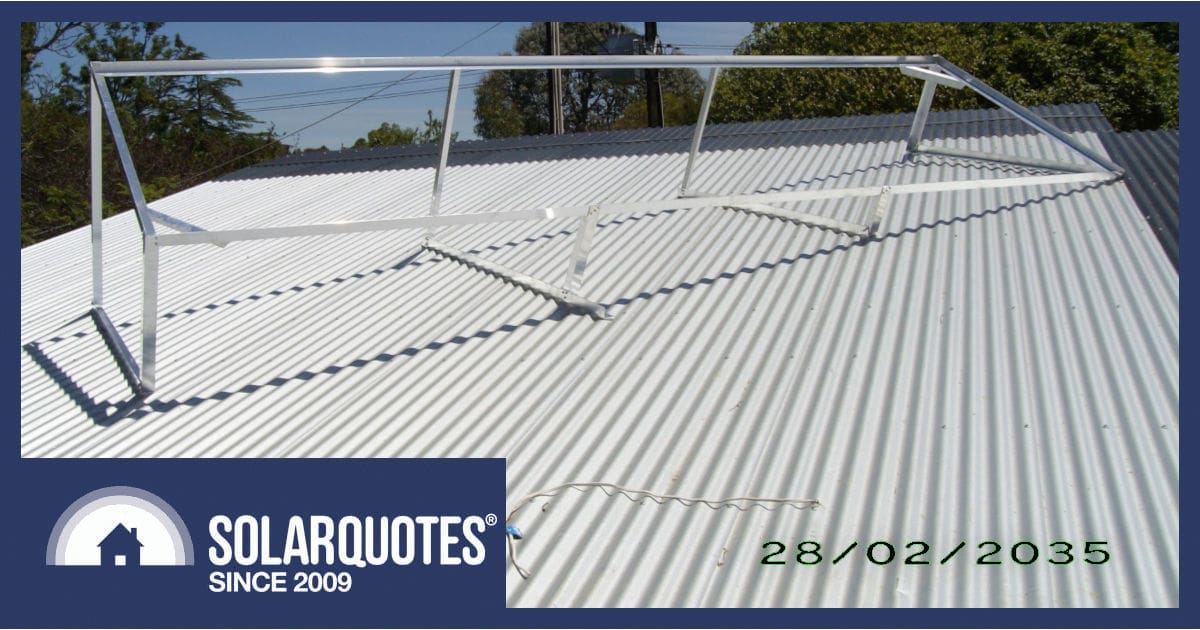
We’re headed back to the future, despite the stamp, this was a frame for 1kW in December 2007
When the Earth was young, feed-in tariffs were 44 cents, and solar panels were $5 per watt, we spent lots of time building angled frames, facing them in exactly the right direction for maximum yield. These days, with bargain panels wholesaling for under $0.25 per watt, you just buy more of them. So, are angled frames dead? I think not, but let’s explore why.
That Was Then
So, for those who’ve done solar design and installation qualifications, one of the fundamental points you learn is that peak solar irradiance is captured somewhere very near the North at a pitch related to the latitude of your address.
For remote area systems, we used seasonally adjustable arrays set up at 45º or more to try and catch as much precious winter sunshine as possible. We’d show the customers how to lay them back flatter to get more summer yield, but this seldom happened because in summer, you had plenty of sun hours, so there was a surplus of energy in any case.
For a grid-connected system around Adelaide, at 20 or 30º pitch, there’s little difference in yearly yield. In fact, for summer solstice, I think 5º south was the optimum angle at midday. And let’s not forget tracking arrays. Introducing moving parts to make solar panels chase the sun across the sky every day is a great way to capture 30% more yield and make perfectly reliable solar into a pain in the arse.
Install tracking solar they said… it’ll be fun they said
This Is Now
Now solar panels are so cheap, the optimal direction for panels is basically ↑up↑
So long as they’re not in the shade, you put them up on the roof, and they create energy. It’s actually been difficult to get some old solar designers to put down the protractor and realise pitched angle frames are no longer needed to improve yield per se.
Framing An Example
This petrol station uses vast amounts of electricity. Installing 100kW would be ideal. Though it wouldn’t meet the demand, it certainly helps lower bills. We had three problems with this job.
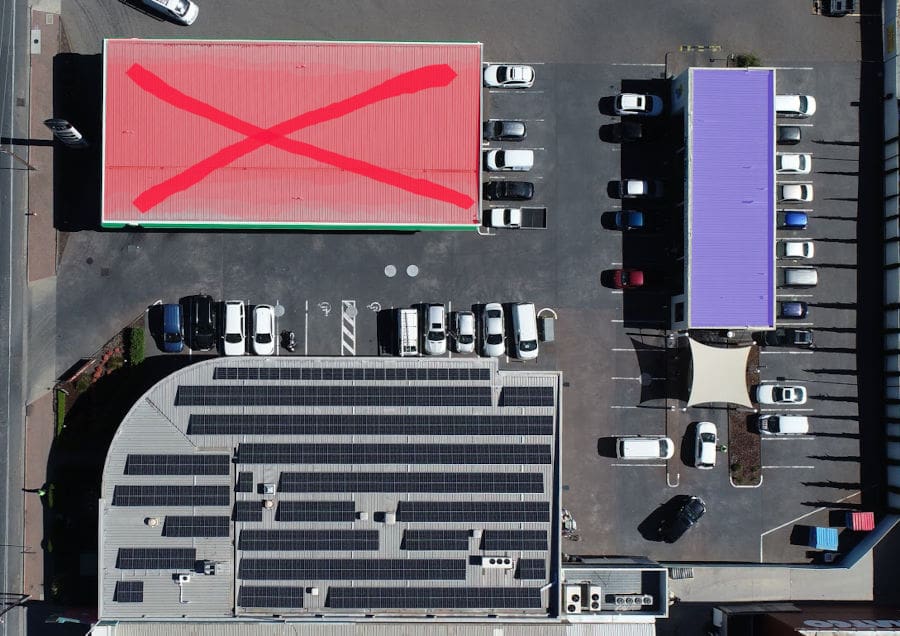
No solar on the red canopy over the petrol pumps. The purple roof required 2% more budget and was deemed too expensive.
Firstly, the short-sighted bean counters wouldn’t buy a little extra control hardware to use the car wash roof. They had a hard threshold for return on investment.
Secondly, the roof on the main building was littered with refrigeration and sloped 3 degrees South.
Thirdly, the salesperson, who shall not be questioned, was absolutely fixed on the idea it had to face north, so she specified angle frames.
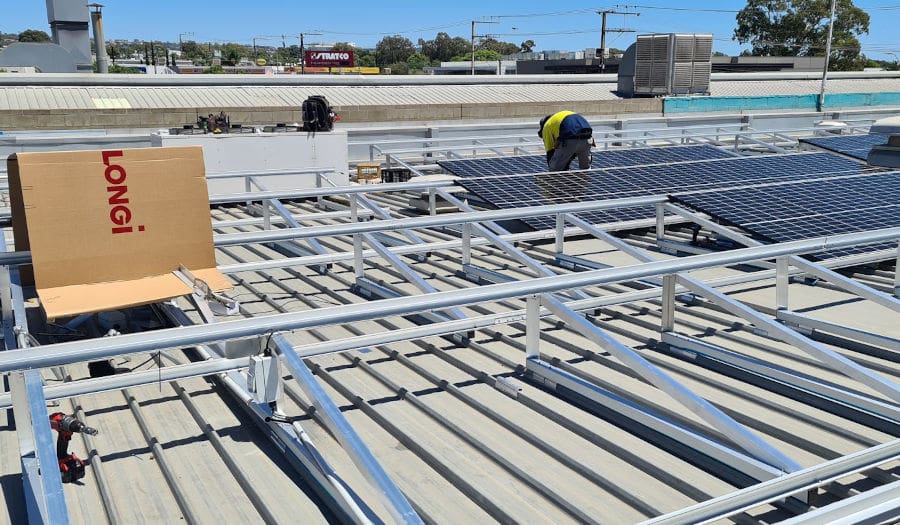
Cardboard cartons provide much-needed shade for electricians. Thank dog, we don’t have to wire up roof-top isolators anymore.
The upshot was we only ended up at 231 modules for around 72.7kW. The system was smaller because we had to waste real estate on inter-row spacing.
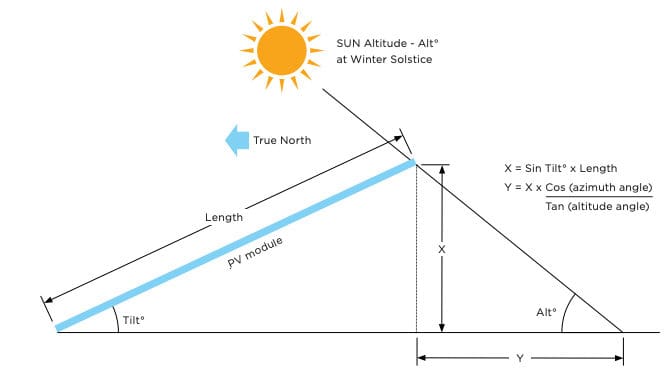
For mathematically challenged roofers, the inter-row spacing to avoid rows of panels shading each other (dimension Y) is roughly 1½ or 2 times dimension X.
Laid flat on the roof, there would simply have been more panels generating more energy. Plus a faster install using less material may even have paid for the extra hardware needed to put more capacity on the other building.
With a flat-on-the-roof design, facing 3° south, it’s feasible to have 308 modules and 97kW, so that kills the notion of angled frames, right?
Getting The Angles Right
We’ve written before about the benefits of self cleaning solar. Having pitched frames means they will stay cleaner and so yield more every single day. In fact the rules for solar installation state that if you have less than 10º slope on your panels, there must be a written warning in the handover pack to alert owners that they will need more maintenance.
Angled frames also mean you have no worries with warranties. When panels are laid flat, they don’t drain properly, which effectively means the bottom edge spends half it’s life standing in a puddle. The risk is that water has an opportunity to seep into the panel and cause earth leakage faults.
The Right Direction Is Up
With Time of Use metering, it makes sense when people say East is the new North. The price of electricity at my house triples at 3pm, so I’ll argue West is so fashionable, it’s the new black. In fact even panels facing South make more sense in Melbourne than they do London.
If you’ve got a flat roof, then the best way to install solar is a “crinkle cut” array.
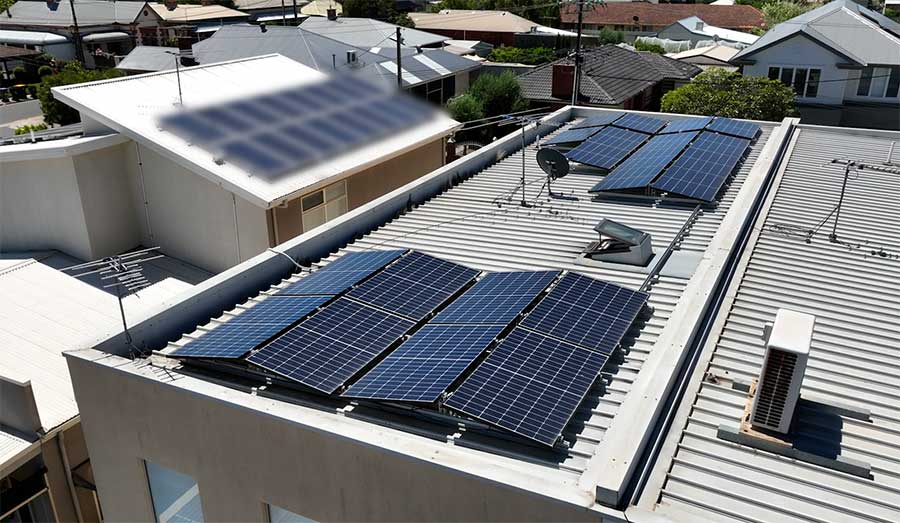
An East/West ‘crinkle cut’ array on a flat roof.
Panels facing East and West on pitched frames will stay cleaner, run cooler and offer more room for maintenance. Better yet, you’ll get more panels into the same roof space, which means you’ll generate more electricity at more valuable times of every day.
Flat Solar Is A Mugs Game
The only downside to “crinkle cut” solar is a little more upfront cost. Getting local council planning permission might be a pain, but the framing and installation itself should only cost an extra 25% at most—around $250/kW or $1500 on your 6.6kW system, in my experience.
It sounds like a lot until you factor in professional cleaning at $200 every six months. Those bills will exceed the cost of angle frames in four years. If the array gets clogged with leaf litter and pigeons, removing the solar to clean the roof will easily cost $1500, whereas you can clean under a pitched frame, even if only one panel needs lifting for access.
Tune in next week, and I’ll run through a detailed comparison of the petrol station mentioned above. There are a few numbers to digest and an explanation of how your solar installer can design it from a desktop and calculate a return with remarkable accuracy.

 RSS - Posts
RSS - Posts



I have been waiting until 100 inch TV’s become common place; likewise I am also holding out until 1000w panels are the norm.
My first panel /system was 6x160watt for 1KW.
Standard residential solar panels contain 60 solar cells (or 120 half-cut solar cells) and typically generate anywhere from 350W to 500W of electricity. The size of these panels can range from 1.6m tall x 1.0m wide, to 1.7m tall x 1.0m wide (5 Feb 2024)
So how long before 2.4m tall x 1.0m wide, and 1000w is standard?
Hi Steven,
More details here :
https://www.solarquotes.com.au/blog/solar-panel-installer-wishlist/
Steven asked “So how long before 2.4m tall x 1.0m wide, and 1000w is standard?”
Yielding 1 kW from 2.4 sq m requiress 41.7% efficiency. The Shockley Queisser efficiency limit for silicon is around 32%, so you’re looking at a three layer panel, harvesting different parts of the spectrum, all at amazing efficiency, I figure. This might be a good time to remember the old adage:
The perfect is the enemy of the good.
What? A number? By 2070 maybe.
(Because it 3x cheaper to make and recycle single layer panels, I figure.
And when the seas rise, the 100+ million refugees can shelter under the extra roof space, awaiting finance for new homes.)
In comparison, instead of holding out for the “about to arrive soonish” 470W REC panels, for 30 kW on my roof, I settled for 420W panels and 27 kW. That has powered both the off-grid house and EV through winter, with the 46 kWh battery back up to 100% pretty much every day. I.e. House & car: zero coal & zero oil, 24/365.
We are what we do, not what we intend, and it is only the photonic kWh we *have already produced* which do anything to ward off a cyclone Yagi in our neighbourhood in a couple of decades.
Thanks for the info
Oxford PV have just begun production of a dual-layer silicon/perovskite panel that lifts efficiency to 24.5%. That’s nice, but not quite enough for us to say “Ooooh!” It’ll apparently pay for itself in large solar farms, as a few % less land is needed. It seems a long long haul to 42%, especially when going two-layer brings so little. (So far, admittedly.) I’d wait to see how well they’ve solved perovskite’s initial durability problems, though.
The standard stuff is so cheap now – if there’s enough roof space for around 25 kW of panels (>20 would probably do), then you can comfortably go off-grid. (My 27 kWp of panels put 14.7 kWh into the EV this afternoon, in solid overcast, at 3.8 kW, tapering to 2.5 kW before sunset.)
Get a good installer (you know how ;-). They’re not all equally competent, efficient, and able to cater to your specific requirements.
I can’t wait for 2070. Thanks for the heads up
“ The only downside to “crinkle cut” solar is a little more upfront cost. Getting local council planning permission might be a pain..”
Excuse my ignorance but are you saying you have to get permission for crinkle cut, but not for say north facing on angled frames?
Hi Mark,
If any panels aren’t parallel to the roof cladding, technically you need council development approval. Solar framing has standard engineering documents but some pedants will want a report on the building structure as well.
Here in Sydney we get a lot of pigeons nesting under solar panels particularly on two-storey roofs..
Is theat an issue when the panels are tilted up? I haven’t noticed any birds under the few tilted erase I’ve seen.
Hi Jacob,
Possums and pigeons like to nest under panels close to the roof. I’ve found they don’t find pitched frames as cosy and attractive.
I’ve cleaned (hosed and brushed) one of my solar arrays (on a conventionally sloping roof) about 3 times in 10 years. It made a noticeable difference for perhaps half an hour. (it was summer and it cooled the panels down… cooler panels = more output).
If your panels are on a FLAT (level) or gently sloping roof, I can imagine debris building up, but not on a conventional sloped roof.
For the major percentage of houses having a large enough north facing roof, like mine, as far as angled solar frames…. not for me. My solar panel power meter (watts out under load) indicates sod all difference in output in say 15 degrees either side of directly facing the sun.
If I was more dedicated, I’d consider arrays also on the east and western roof slopes… but I’m not going to burn my generous old FIT to do that.
I have been doing a fair bit of reading lately about string inverters versus micro inverters and have come to the conclusion that the latter are the way of the future. Besides the extra
cost, I can’t see why all installations now are not incorporating micro inverters?
Do you have an opinion on this observation?
Hi Stephen,
Micros are fine for complex roofs but they’re expensive compared to string inverters and won’t handle 200% solar oversizing which makes hybrid battery inverters a real no brainer.
What it means is that micros can be an artificial ceiling on solar capacity, especially if your DNSP has a hard 10kW/phase connection limit. In some instances an enphase system could only be 5kW of inverters & 6.6kW of panels plus a 5kWh battery.
Hi Anthony
Thanks for your response!
I’m not the full bottle on all things solar but I’m trying to learn more!
Are you meaning that by oversizing is using higher wattage panels than the inverters max capacity ie clipping?
I have come across a small company in Sydney called Penrith Solar Center who are only installing micro inverters.
I am already up to my third fronius string inverter and have had a lot of non productive days !
Hi Stephen,
Penrith Solar are great but by no means small. They use Enphase for everything.
I would be very surprised to hear of multiple Fronius failures, they’re very reliable in my experience and very good with warranty claims when needed. Who installed your original system?
Basically everyone runs inverters with more solar than the nameplate rating but generally that means 133% is the ceiling because of dumb Australian rules. Inverter makers will allow 150% 200% or even more however Enphase are a bit more limited in my experience because you need to get precisely the right panel specification to fully overdrive them.
Hi Anthony
That’s the problem I had when I wanted to put extra panels on. My micro-inverters were already at 10kW (Ausgrid) so no more panels for me.
But… now …
NS194 Clause -5.3.1 – In accordance with Appendix C2 of AS/NZS4777.1:2024 Appendix, Ausgrid will allow up to 30kVA of total Inverter Capacity (including AC-coupled battery inverters) to be connected to a single phase supply point provided that the premise electrical installation is appropriately rated (e.g. switchboard rating, cabling) and the export to the grid is limited to no more than 10kVA (note this is above the 5kVA specified in AS/NZS4777.1:2024). A design must be provided showing how the export limiting will be configured.
So, wife willing, I’ll put some more panels on the E facing roof
Let us know how you get on Chris.
Re cleaning – we have 6 kW on an 11 degree south facing roof. It annually gets about the same as 5kW on frames facing north. Anyway (as an obsessive compulsive engineer) armed with years of PV output data, I estimated the optimal cleaning interval. Clean every 6 months and you would pay far more for cleaning than you would save in generation. Clean every 10 years and the converse applies.
My result is that if you estimate the accumulated loss of output (assuming to are a nerd) and know the cost of cleaning, the answer is: (drum roll) when the accumulated cost of loss of output equals the cost of a clean.
In our case it’s about once every 5 years.
What works well is to design the house/extension with solar in mind. On my DIY designed and owner-built extension, a 25m long north facing roof, tilted up at 40 degrees gives nearly double the winter yield of flat – with panels flat to the roof. At 37.8 deg S latitude:
Tilt Yield Winter Effectiveness
Flat: summer: 97%, winter: 48% , equinox: 79% Poor
40°: summer: 90%, winter: 93% , equinox: 99.9% Winter: x1.94
-14°: summer: 88%, winter: 25.5%, equinox: 62% Very poor winter.
The great winter performance of the 10 kW 40 deg tilted north array fills the hole in the winter yield of the 11 kW 14 deg tilted south array, which nevertheless does OK the rest of the year, and in overcast.
Even off-grid, without semi-lucrative afternoon export potential, the 40 degree tilted west array catches late afternoon sun to power an aircon without the battery drain which would otherwise occur once the sun has slipped of the north facing array.
I took your hint, and had the installer fit plastic coated stainlesss steel bird mesh skirts on the arrays.
The insane 130 km/h winds which roared through the other week, let alone what will rip through in a decade, make me very glad I did not stick panels up in the air to help them rip my roof off.
Brilliant!
Yes. In cold climates, like Canberra, it’s all about maximising winter production. There will always be excess the rest of the year. In the future, outside winter, middle of the day export will have very little value. Getting battery charged for winter evenings will maximise savings.
“Thank dog, we don’t have to …”
Now that is a comment I wholeheartedly agree with. Thank Dog indeed ✅
as a commited atheist i use that expression often
& OMD as well!
good point well made! (The Royle Family)
Thanks…. I’ve added that phrase to my vocabulary! I might get a few furrowed brows from some pious folks I share oxygen with.
I live on the Northern Beaches in Sydney and am looking for someone who can provide professional guidance/ consulting on setting up battery management. My installation is 10.3Kw array, 2x Huawei Hybrid 5Kw single phase inverters and a Huawei Luna 2000 15 Kw battery.All works well
Huawei withdrew direct support for batteries in Australia in 9/23 so am looking for another way to manage the battery into Amber Electric. Amber did provide support when i joined them ( via Evergen) but subsequently withdrew the offer
Would stress i am NOT looking for sales support
Hi Kevin,
Talk to iStore. They now import Huawei hardware with iStore branding. They offer local support, locally developed management software and locally hosted app.
I am having tilt put on my east and west facing panels to take advantage of the bifacial panels i am having installed. Hopefully getting a little extra power generation morning and afternoon.